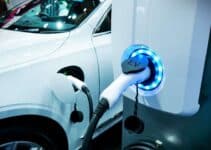
To support the transformation to software-defined vehicles, players from the tech industry and the auto industry must collaborate.
Image Credit: SERGII IAREMENKO / SCIENCE PHOTO LIBRARY via Getty
Learn how your company can create applications to automate tasks and generate further efficiencies through low-code/no-code tools on November 9 at the virtual Low-Code/No-Code Summit. Register here.
California is enacting “a sweeping plan to restrict and ultimately ban the sale of gasoline-powered cars,” which Governor Gavin Newsom described as the “beginning of the end for the internal combustion engine.” Where California leads, many others follow. However, at present, there is no technology available that will allow for the mass adoption of electric vehicles (EVs) at a price point that the average consumer can afford. While policies like California’s aim to accelerate the global transition toward electric vehicles, there are crucial missing pieces to this plan.
Electric vehicles: Batteries, barriers and bans
Let’s get clear about what we’re working toward and the barriers to getting there. Most electric vehicles today use a lithium-ion battery that requires cobalt and nickel to function for long-range travel, which means that their batteries and the cars are expensive. The batteries that do use low-cost materials lack the range to be competitive with internal combustion for everyday consumers.
Based on current technology, the world is not even close to being on track to achieving California’s goal of banning the sale of new gasoline-powered cars and light trucks by 2035. The industry hasn’t yet defined a profitable roadmap to get there.
Scale alone can’t solve this with current technology. At the moment, doing the same thing in ever larger and larger factories won’t help automakers or consumers. Cobalt and nickel are becoming scarcer and more expensive as demand grows. It’s uncertain whether global miners will even be able to keep up with demand for these materials at current growth rates, let alone the growth rates needed for 100% of new cars to be electric by 2035.
Event
Low-Code/No-Code Summit
Join today’s leading executives at the Low-Code/No-Code Summit virtually on November 9. Register for your free pass today.
Nickel prices soared from $29,000 a ton to about $100,000 in March 2022 and continue to fluctuate wildly. Cobalt mining is particularly problematic on ethical grounds, predominantly performed in the Democratic Republic of Congo in unregulated mines that lack adequate safeguards against child labor and corruption.
Electric vehicles still out of reach for most
Cheaper batteries depend on the development of new technology as soon as possible. Until then, EVs are very difficult to produce profitably across an entire automotive product line. Expensive luxury vehicles at the top end of a product line give an automaker the glow of an EV future, but lower-cost electric cars currently depend on government subsidies to reach mid-range consumer price points.
The truth is that with today’s EV battery technology, automakers can’t produce the affordable first car for a newly employed college grad. They also can’t make a utility van for a hard-working contractor or an SUV for a single parent juggling two jobs.
To achieve mass adoption, battery costs must come down. An EV battery involves a complex system of chemical storage that depends on an anode on one side and a cathode on the other, with a dance of lithium between the two. Multiple technologies are pushing to make a step-change in the cost of these batteries, but the road to getting new materials into a car on a dealer’s lot is long and complex.
To lower costs on the anode side of a battery, one could switch to higher-energy materials like lithium itself, or shoehorn in more high-energy silicon. Both of these approaches involve technical challenges that dozens of startup companies as well as major battery companies and universities have been working on for decades. Promising technologies in solid state anodes and nano-structured silicon, along with technology to increase the use of polymers in batteries, have combined over time to increase energy on the anode side.
With billions invested in bringing the tech to market, these innovations are just now getting tested widely in cars on the road, but this is only half of the equation.
The quest for sulfur cathodes
What has long been seen as the end-game material on the cathode side of the battery is cheap and abundant sulfur, but it has been devilishly hard to make it work. While no other realistic material on the periodic table matches it in energy potential, getting sulfur to perform to automotive specifications has been a decades-long challenge.
Where cobalt- and nickel-based batteries hold the energy of lithium in a crystal structure, sulfur contains lithium in a chemical conversion that creates by-products, making for poor battery performance. A handful of startups have pushed sulfur cathodes forward for decades but never quite produced a battery that can be third-party tested and put on the long and expensive road to being validated for an electric car.
One way to get sulfur across the “valley of death,” in the same way anode innovations are just now clawing out the other side of the valley, is to temper it in the forge of commercial-level testing. Build a sulfur battery at the same specifications needed for an automotive battery and make it fail over and over and over again. Every time you make it fail, figure out why and work around the failure mode. Combine chemistry, engineering, and innovations from universities, and you can start to push a sulfur system closer and closer to automotive performance levels.
I lead a startup company called Conamix and while we’re pushing the sulfur system and we’re tantalizingly close, we’re not yet good enough for third-party testing for automobiles.
Betting on new technology
Whether it is an innovation on the cathode side or the anode side of the battery, it still takes three to six years from third-party validation to move it to a car that a consumer can buy and drive. An automaker needs to know a new material works in ever-larger battery cells and that it can be produced in existing factories and at a truly massive scale.
The world need billions and billions of battery cells to achieve a 100% EV future. Companies like the one I founded back in 2014 are on the cutting edge of new materials that could someday change the dynamic of EV pricing worldwide. And we make only dozens of cells per day.
So there’s a gap. A promise gap — between the fully electrified future pushed by California and the reality of how hard it is to get new materials to market. Multiple technical holy grails have yet to be found and proved and pushed from the rough-and-tumble of a venture-backed startup to the scale that makes a difference for every consumer and, ultimately, for the planet as a whole.
If the world is going to have a hope of meeting these ambitious goals, we need to make big and smart bets on new technology at the same scale we make deadlines and promises.
Charlotte Hamilton is the co-founder and CEO of Conamix.
DataDecisionMakers
Welcome to the VentureBeat community!
DataDecisionMakers is where experts, including the technical people doing data work, can share data-related insights and innovation.
If you want to read about cutting-edge ideas and up-to-date information, best practices, and the future of data and data tech, join us at DataDecisionMakers.
You might even consider contributing an article of your own!


